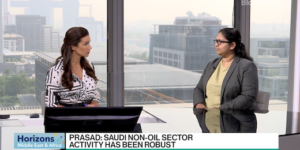The opinion piece titled “The Gulf is on track to lead global climate tech” appeared in theArabian Gulf Business Insight (AGBI) on 3rd October 2023.
An extended version of the article is published below.
The Gulf is on track to lead global climate tech
We need to focus on mitigating the risks and adapting
The catastrophe in Libya’s Derna valley basin is a deadly reminder of how climate change is increasing the frequency and strength of Mediterranean hurricanes.
Pakistan’s floods were the worst disaster in a decade, uprooting 33 million people. Both events overwhelmed ill-designed, badly maintained legacy infrastructure. Everywhere on the globe faces similar threats.
The Middle East and North Africa (MENA) is one of the regions most severely affected by what the UN recently called climate breakdown.
This will involve battling extreme weather events, rising temperatures, increased water stress, rising sea levels, falling rainfall, dwindling agricultural output and growing desertification.
MENA is already the ‘most water-stressed region in the world’, where 83% of the population is exposed to “extremely high” water stress [1], with an increasing frequency of climate disasters (such as droughts and floods) destroying habitats. The IMF estimates that a 1° Celsius increase in temperature in five of the region’s hottest countries [2] would lead to a massive decline in per capita economic growth of around 2 percentage points. High population growth rates and rapid urbanization levels escalate the risks and challenges of climate change faced by the governments and populations of the region.
Despite global and regional energy transition commitments, it is delusional to believe that the human species will overcome divisive geopolitics and contradictory interests and undertake the radical strategies to limit warming to 1.5C by 2030, or 2.5C by 2050.
We need to focus on mitigating the risks and adapting. This means moving beyond renewable energy, mobility and energy storage to massive, sustained investment in climate-resilient infrastructure and related technologies.
The global urban infrastructure investment gap alone is estimated to be over US$4.5 trillion per year, with a premium of 9-27% required to make infrastructure low carbon and climate resilient, according to the World Bank. Climate resilient infrastructure has to be planned, designed, built, operated, and maintained in a way that anticipates and adapts to changing climate conditions to provide cities and communities with climate resilient services.
Water management
Global water demand is projected to increase by 20-25 percent by 2050, and it is likely that 100 percent of the MENA region’s population will live with “extremely high” water stress by 2050. If not countered, this could lead to growing political instability and potential water wars.
The impact of water stress needs to be addressed through regional co-operation and management for common water resources, such as the Nile and Euphrates.
At the national level, policy tools are required. Rational, economic pricing of scarce water resources will underpin more efficient management of everyday use. The deployment of climate tech investments to increase scarce resources is imperative.
Desalination exports
Desalination is the main answer to avoid depleting non-renewable aquifer resources. The GCC has a comparative advantage: it accounts for more than 50 percent of global water desalination capacity. In addition, the GCC Secretariat anticipates that the Gulf will boost such capacity by 37 percent over the next five years, by investing $100 billion.
Desalination is increasingly powered by solar energy, helping both energy and water security.
Saudi Arabia’s giga-project Neom is developing a reverse osmosis desalination facility entirely powered by renewables, while there are other solar-powered desalination plants in the UAE and Oman.
Tried and tested in the GCC, this exportable technology can address the growing global water availability gap and water stress.
Increasing temperatures
Rising temperatures drive up demand for air conditioning, with cooling representing up to 70 percent of peak energy consumption. As a result, ownership will increase from 37 percent of the global population today to more than 45 percent in 2030. But this is a legacy technology.
District cooling (equivalent to district heating) delivers chilled water to buildings and provides sustainable cooling powered by renewable energies. It is up to 10 times more energy-efficient and cost-effective than traditional air conditioners.
The GCC states have pioneered and implemented district cooling as an integral part of their public utilities’ infrastructure, real estate and urban developments. The model and technology could be exported to the rest of Mena and to rapidly growing and urbanising Africa, South Asia and elsewhere.
District cooling can be deployed in new urban developments and existing buildings can be retrofitted and connected to necessary plants. Increased global adoption could save $1 trillion in energy costs by 2035.
Furthermore, it is incorporating new technologies, including digitalisation and AI, along with integrating renewable energy sources into existing models, supporting the energy transition.
Tackling food security
The MENA region’s southern and eastern Mediterranean region has witnessed a decline in total precipitation, by around 8.3% per decade in the period 1980-2022, directly threatening agriculture-based communities and food security. The rest of the region is facing the existential threat of increased desertification.
To partially adapt and address food security issues, the highly food-importing dependent GCC nations have been massively investing in desert agriculture technologies and Agritech [3] to increase domestic production, with hydroponics and seawater farming rapidly expanding. Shifting to a climate-smart approach to agriculture will be key for the region, to achieve food security and adapt to warming climate conditions. Again, the GCC has developed the ability to export desertic agriculture and Agritech to the wider region.
Financial resources
All this will require substantial, sustained financing. The GCC sovereign wealth funds are among the largest global investors in renewable energy.
The region’s international financial centres are gradually developing instruments that can facilitate access to finance for indigenous climate tech companies.
These vibrant, innovative private businesses should also be incentivised by reducing barriers to entry, streamlining and reducing regulations. They also need access to climate data.
With financial firepower exceeding $4 trillion, the Gulf can potentially become the location for global climate finance and tech, as well as the latter’s main exporter. To increase their “soft power” and as major capital exporters and aid providers, the GCC should integrate climate tech and finance into their foreign trade, aid and cooperation programmes.
As the UAE prepares to host COP28, it is anticipated that the GCC’s wealth funds, financial markets and active private sector will increasingly diversify their investments into resilient infrastructure and climate tech.
Adapting in these ways to the risks the region faces is not only the right response; it will increase mobility and clean energy adoption within MENA and around the world.
Footnotes:
[1] According to the World Resources Institute, globally the five most water-stressed countries are Bahrain, Cyprus, Kuwait, Lebanon, Oman and Qatar.
[2] Bahrain, Djibouti, Mauritania, Qatar, and the UAE.
[3] According to a joint report by the Sharjah Research Technology and Innovation Park and Deep Knowledge Analytics (Nov 2022), UAE’s Agritech sector comprises 36% indoor farming, 15.9% precision agriculture, and 15% agri inputs. Around 65% of Agritech firms in the UAE are micro-sized (with less than 50 employees).






